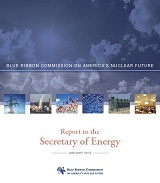US Secretary of Energy Moniz at ANS Opening Plenary
Moniz on Nuclear

A message from Electrical Builders, Ind.
America’s Top Performing Nuclear Plants Rely on Electrical Builders, Industries to Expand and Extend the Life of Their Critical Electrical Assets
Moniz on Nuclear
Breaking the used nuclear fuel logjam?
 The US Department of Energy has a $452 million program to share development and licensing costs for selected small modular reactor (SMR) designs. The DOE's goal is to have an operating SMR by ~2022. Last November, the DOE awarded the first grant to the B&W mPowerTM reactor. In more recent news, the DOE has decided to issue a follow-on solicitation to enter a similar cost-sharing agreement with one or more other SMR vendors (and their SMR designs). The status of development and licensing for several SMR designs are summarized below.
The US Department of Energy has a $452 million program to share development and licensing costs for selected small modular reactor (SMR) designs. The DOE's goal is to have an operating SMR by ~2022. Last November, the DOE awarded the first grant to the B&W mPowerTM reactor. In more recent news, the DOE has decided to issue a follow-on solicitation to enter a similar cost-sharing agreement with one or more other SMR vendors (and their SMR designs). The status of development and licensing for several SMR designs are summarized below.
Taxpayers for Common Sense on February 27 issued a press release targeting the Department of Energy for "wasting more than half a billion dollars" on its small modular reactor (SMR) development cost-sharing program. Leaving aside the historically essential role of government investment in developing, advancing, and bringing to market innovative energy technologies-and the fact that early government investments in nuclear energy technology now pay back enormous dividends to all Americans in billions of dollars' worth of affordable and emission-free electricity generation every year-many of the advantages of advanced SMR energy technologies were overlooked or misconstrued in the group's press release and policy brief.
 This month's post discusses my ideas on an issue I've been thinking about for awhile. Although we have four new reactors under construction in the United States (at Vogtle and Summer), the nuclear "renaissance" has so far not been nearly as strong as many had hoped. This begs the question as to what is holding nuclear back.
This month's post discusses my ideas on an issue I've been thinking about for awhile. Although we have four new reactors under construction in the United States (at Vogtle and Summer), the nuclear "renaissance" has so far not been nearly as strong as many had hoped. This begs the question as to what is holding nuclear back.
Plus a few pointers to what's in store for 2013
A joint Department of Energy and NASA team has demonstrated a simple, robust fission reactor prototype [note: see Comments for more accurate and complete description] intended for development for future space exploration missions. The DUFF (Demonstration Using Flattop Fissions) experiment represents the first demonstration in the United State-since 1965-of a space nuclear reactor system to produce electricity.
Robert Alvarez has issued another misleading report about energy dense fuel materials, titled Managing the Uranium-233 Stockpile of the United States.
 Several important events have recently occurred involving the U.S. Nuclear Regulatory Commission, the Yucca Mountain nuclear waste repository, and the interactions between the two.
Several important events have recently occurred involving the U.S. Nuclear Regulatory Commission, the Yucca Mountain nuclear waste repository, and the interactions between the two.
Getting the NRC license is just the first step
Westinghouse gets support from Missouri for 225-MW reactor
On Friday, March 30, American Nuclear Society President Eric Loewen submitted outside written testimony on behalf of the American Nuclear Society to the U.S. House Appropriations Subcommittee on Energy and Water Development. The testimony addresses on Fiscal Year (FY) 2013 appropriations for the U.S. Department of Energy (DOE) and other relevant agencies under the Subcommittee's jurisdiction-in particular, funding for nuclear programs under DOE's Office of Nuclear Energy.
 After giving a brief update on recent Fukushima-related events in the United States, I'd like to talk about some good (but relatively unpublicized) things that have happened during what has otherwise been a very challenging year for the nuclear industry. Then I'll discuss what, to me, was the most disconcerting story in the past year.
After giving a brief update on recent Fukushima-related events in the United States, I'd like to talk about some good (but relatively unpublicized) things that have happened during what has otherwise been a very challenging year for the nuclear industry. Then I'll discuss what, to me, was the most disconcerting story in the past year.
Steven A. Arndt, Ph.D., P.E., cited as best engineer in federal service
Eric Loewen, president of the American Nuclear Society, kept up his rapid pace last week as he visited the ANS local section in Aiken, S.C., on February 15, and the one in Charlotte, N.C., on February 16. Loewen, as the featured speaker at the meetings of the two sections, presented his personal talk titled "Plutonium: Promise or Peril".
 Soon after declaring that it would end the Yucca Mountain repository project, the Obama administration created the Blue Ribbon Commission on America's Nuclear Future to reevaluate the nation's nuclear waste program and policies. The commission was asked to recommend improvements to the waste program and the Nuclear Waste Policy Act (NWPA), and to make general recommendations on the path forward. The commission was specifically instructed to not address the Yucca Mountain project, or any specific project or site. The commission's final report was released this month.
Soon after declaring that it would end the Yucca Mountain repository project, the Obama administration created the Blue Ribbon Commission on America's Nuclear Future to reevaluate the nation's nuclear waste program and policies. The commission was asked to recommend improvements to the waste program and the Nuclear Waste Policy Act (NWPA), and to make general recommendations on the path forward. The commission was specifically instructed to not address the Yucca Mountain project, or any specific project or site. The commission's final report was released this month.
 The Blue Ribbon Commission on America's Nuclear Future released its final report on Thursday, January 26. The report contains recommendations for a comprehensive U.S. strategy for managing spent nuclear fuel and high-level radioactive waste.
The Blue Ribbon Commission on America's Nuclear Future released its final report on Thursday, January 26. The report contains recommendations for a comprehensive U.S. strategy for managing spent nuclear fuel and high-level radioactive waste.
The utility is assessing options to use it
(This article summarizes a paper presented by the author at the ASME 2011 Small Modular Reactors Symposium)